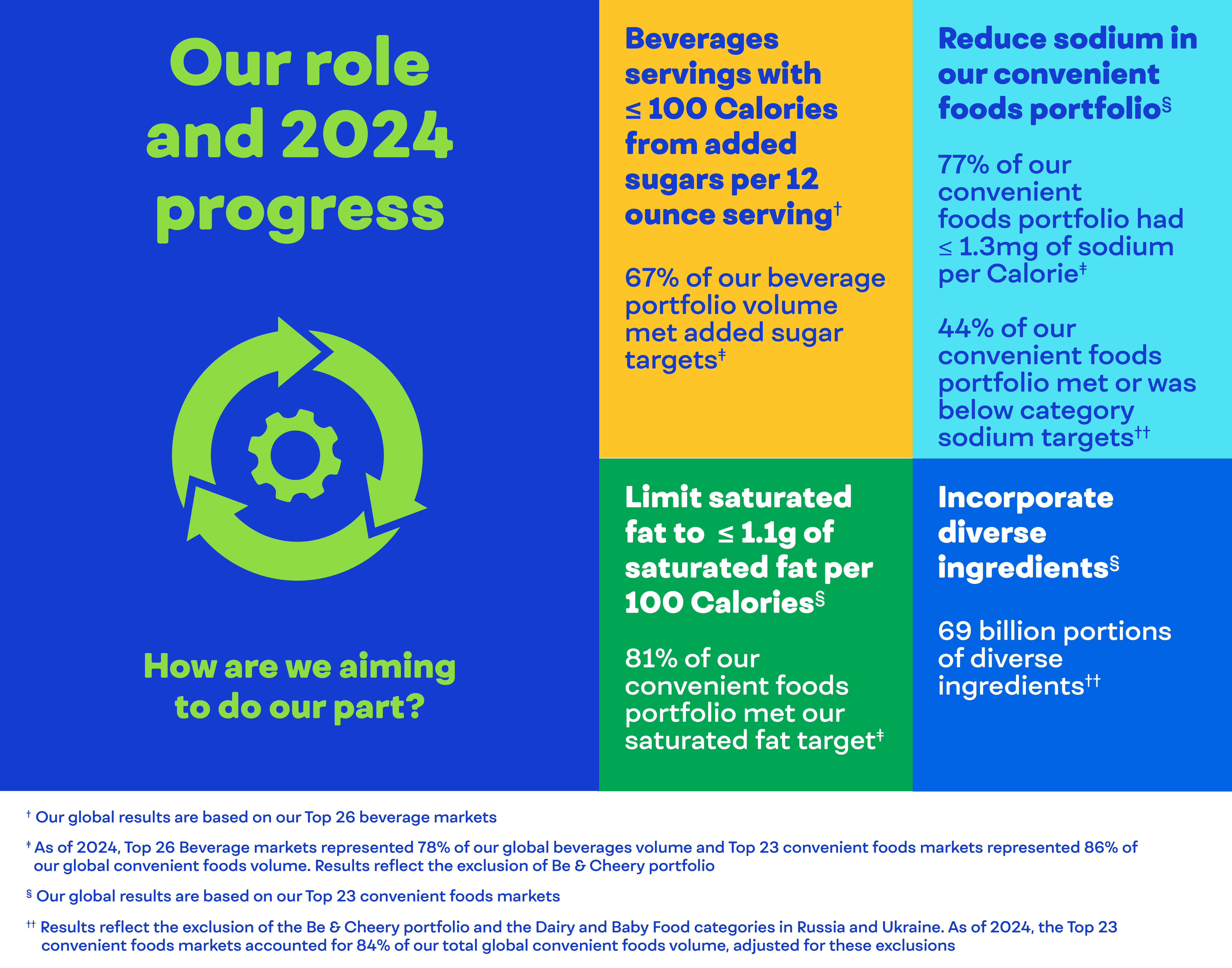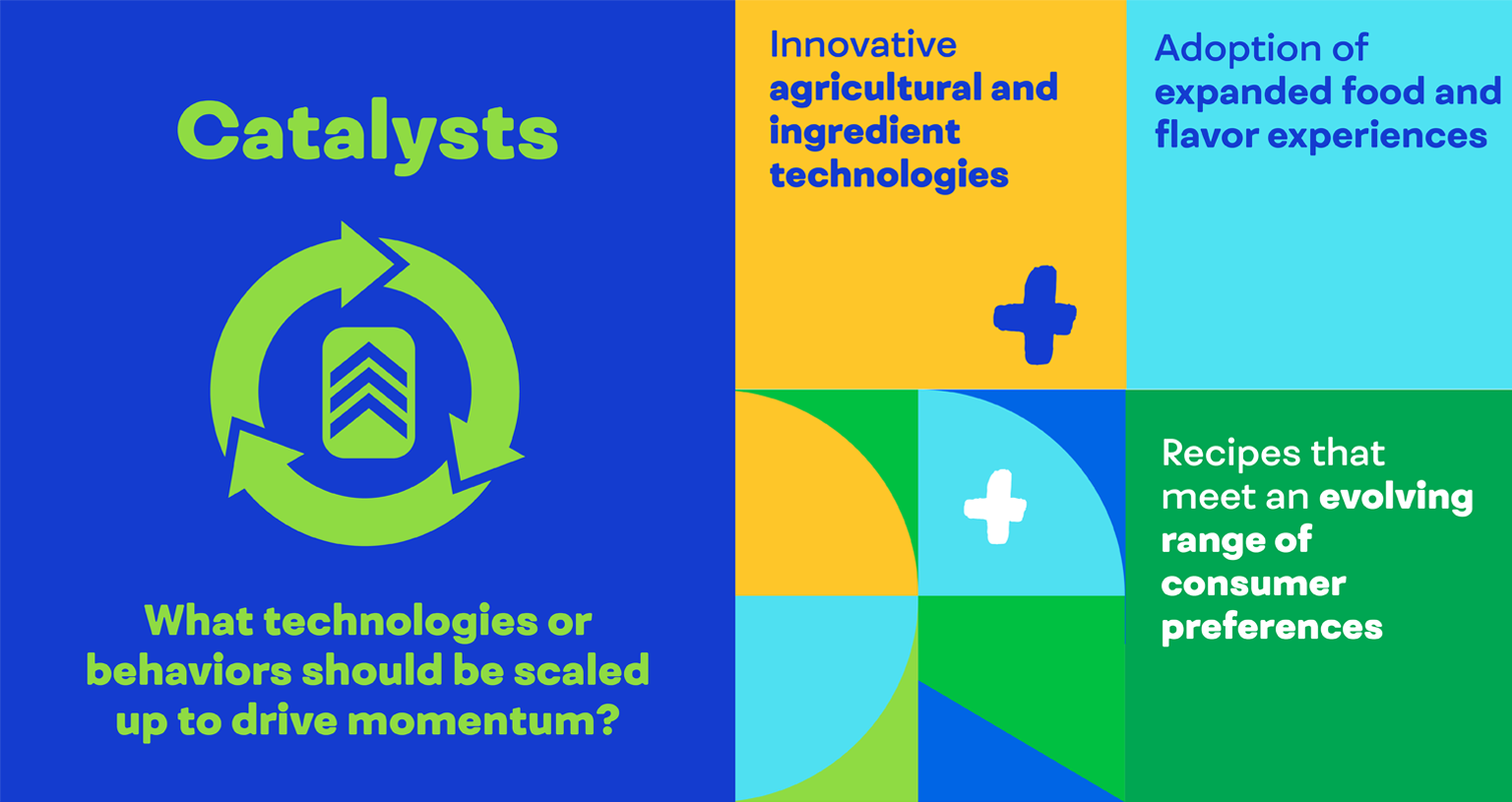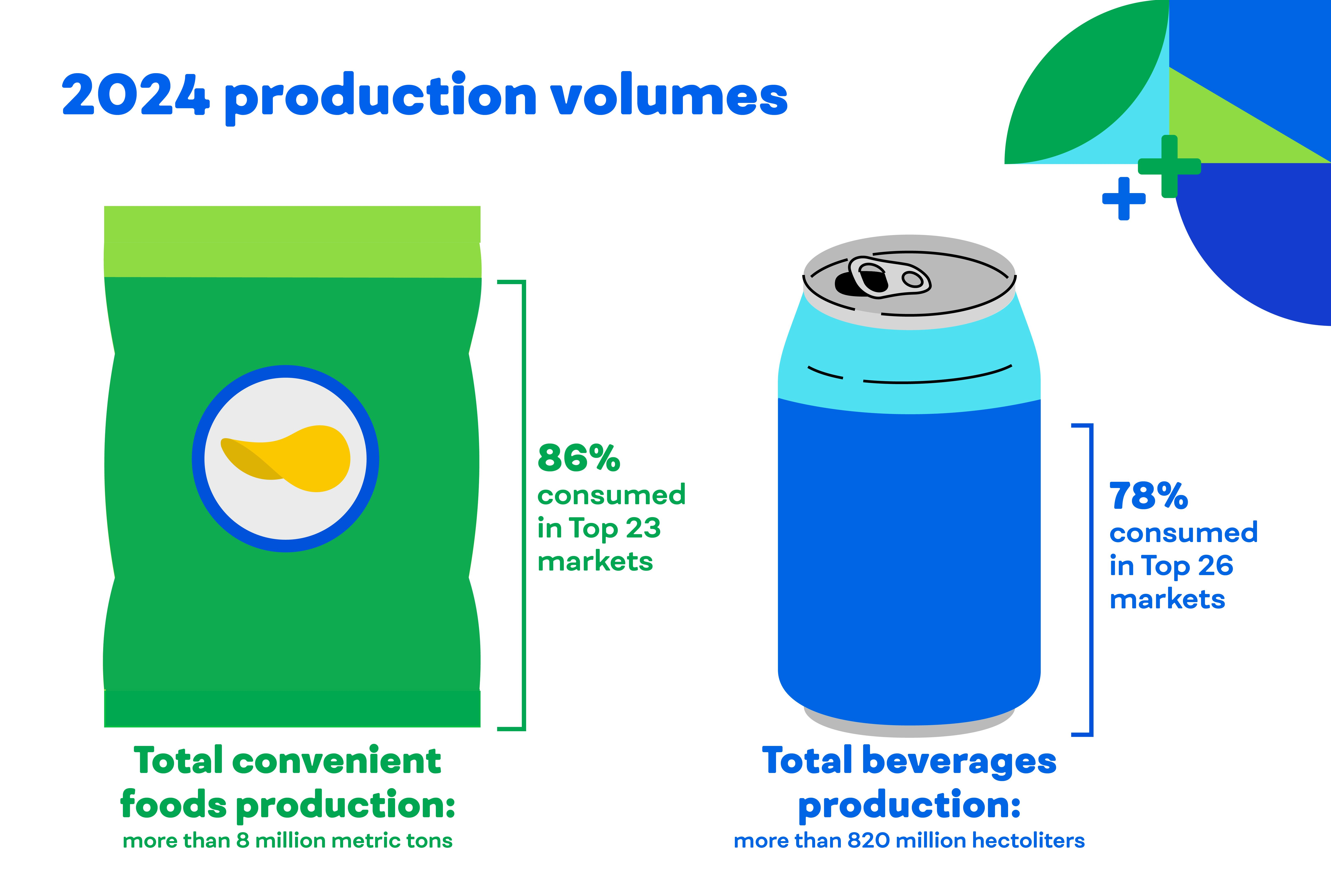ESG Topics A-Z
Nutrition

To PepsiCo:
Consumers enjoy PepsiCo products more than one billion times a day, all around the world. With that scale comes an opportunity to provide people and families with foods and beverages that are enjoyable and fit their lifestyle. As consumers’ tastes evolve, and nutrition and recommendations are developed by health authorities and regulatory bodies, we continue to adapt our portfolio and product offerings to remain a leading convenient foods and drinks company.
To the World:
Consuming an excess of added sugars, sodium or saturated fats are leading risk factors across the globe for diet-related conditions. At the same time, many people around the world are not eating enough nutritious food groups and ingredients. Although many of our products are not intended to be core elements of the daily diet, we aim to set ambitious nutrition goals that will enable us to offer an array of positive choices, now and for many years to come.
Approach
We strive to be an industry leader and set ambitious nutrition goals that are aligned with guidance from health authorities and regulatory bodies. In our nutrition efforts, we aim to reflect consumer taste preferences and local expectations while meeting regulatory requirements. Our nutrition ambitions focus on a set of key nutrients to limit (saturated fat, sodium, added sugar and industrially-produced trans fat), as well as delivering diverse ingredients in our snacks and beverages.
Saturated fat
Saturated fats occur naturally in many foods. While the main dietary sources of saturated fat are meat and dairy products, all fats and oils in a diet will contain a mixture of fatty acids including a proportion of saturated fatty acids. The current World Health Organization (WHO) dietary guidelines recommend that no more than 10% of total dietary energy intake be derived from saturated fat.
Informed by these international guidelines and those of national health authorities, we have set a goal that aims to help consumers reduce the amount of saturated fat in their diets. As we strive to reach our pep+ (PepsiCo Positive) ambitions, our 2025 goal is that at least three quarters of our global foods portfolio sales volume will not exceed 1.1 grams (g) of saturated fat per 100 Calories.1 Our goal is designed to shift a significant portion of our convenient foods portfolio towards lower saturated fat levels to make it easier for our consumers to follow WHO’s recommendation by offering more Positive Choices.
Sodium
Sodium, an essential mineral that occurs naturally in foods, can also be added to food during processing for functional reasons and/or taste characteristics and by the consumer as “table salt”. We have set goals, considering guidance from public health authorities including the WHO, to help consumers reduce the amount of sodium in their diets. Our goals are that:
| PepsiCo convenient foods category | 2030 category sodium threshold (mg/100g) |
| Ready-to-eat cereals | 280 |
| Plain hot cereals | 100 |
| Sweet hot cereals | 280 |
| Standard potato crisps | 500 |
| Sheeted snacks | 520 |
| Extruded snacks | 520 |
| Pelleted snacks | 520 |
| Snack mixes | 520 |
| Pretzels | 760 |
| Popcorn | 280 |
| Nuts and seeds | 280 |
| Sweet biscuits | 265 |
| Savory biscuits and salted crackers | 600 |
| Pasta/noodles/grains (concentrate or dry mix) | 770 |
| Pasta/noodles/grains (prepared) | 230 |
| Dips and dipping sauces | 360 |
| Emulsion based dips (cream/cheese dips) | 500 |
| Cereal, nut and granola Bars | 380 |
| Breads and rolls, including those with additions | 330 |
| Condiments | 650 |
| Yeast raised desserts and morning goods (cakes and sponges) | 205 |
| Yeast raised desserts and morning goods (pies and pastries) | 120 |
| Confectionery | 200 |
| Plain flour | 100 |
| Self raising/rising flour | 1,300 |
| Plain pasta | 25 |
| Dessert baking dry mixes | 780 |
| Unflavored rice/pasta/noodles/grains | 25 |
| Dried fruit (plain) | 100 |
| Fruit snacks | 200 |
| Syrup | 100 |
| Variety/pancake baking dry mixes | 960 |
| Frozen/refrigerated dough and batter (breads and rolls) | 375 |
| Frozen/refrigerated dough and batter (muffins and brownies) | 250 |
| Dried beans/pulses | 25 |
| Soups ready-to-eat (shelf stable and refrigerated) | 235 |
Sugar
Global and many national dietary guidelines recommend reducing added or free sugars consumption as one aspect of a more comprehensive approach to overall health and wellness. The WHO recommends people consume no more than 25g of free sugars per day.
We are working to limit products to 100 Calories or fewer from added sugars per 12 fluid ounce serving in at least 67% of our beverage portfolio by volume by 2025.2 This goal is designed to shift a significant portion of our beverage portfolio towards lower added sugars levels that can help consumers lower their intake of added sugars.
Our two-pronged strategy to accomplish this is based on reformulating our existing beverages to reduce added sugars and innovating to develop new products that are significantly lower in added sugars.
Trans Fat
We support public health objectives to reduce industrially-produced trans fats (iTFA) in the food supply, and view this as an important part of our pep+ ambitions to evolve our portfolio to transition to healthier oils.
As a member of the International Food and Beverage Alliance (IFBA), PepsiCo has committed:
- Not to exceed 2g iTFA per 100g of fat/oil per product by end of 2023, in line with the WHO's overall objective of phasing out iTFA and partially hydrogenated oils (PHOs) from the global food supply — a goal which we met as of 2023.1
- To share best practices and help guide other companies, particularly small and medium enterprises, in the reduction of iTFA.
PHOs are the main source of industrially-produced trans fat.3
PepsiCo has led the industry in removing PHOs and transitioning to alternatives such as corn, canola and sunflower oils.4 In addition to iTFA found in PHOs, iTFA can form at low levels during the oil refining process. PepsiCo’s Research and Development (R&D) teams and Global Oils Center of Excellence work with our suppliers to ensure they are deploying best practices to limit this incidental iTFA formation and have updated our ingredient specifications to ensure that they comply with the IFBA target.
Diverse ingredients
We define diverse ingredients as food groups or ingredients – such as legumes, whole grains, plant-based proteins, fruits and vegetables and nuts and seeds – that people do not consume enough of in many countries. Increased consumption of diverse ingredients can help promote a more nutritionally diverse diet. Our 2030 goal is to deliver 145 billion portions of diverse ingredients annually in our global convenient foods portfolio1 and to ensure each portion will provide approximately 10% of the suggested daily amount of a diverse ingredient.5
Regional nutrition ambitions
In addition to our nutrient- and ingredient-specific ambitions, teams across the globe have worked with select local governments to establish additional objectives based on local dietary recommendations.
For example, in the European Union, where many countries have adopted the Nutri-Score nutrient profiling model, we have set an ambition to grow our “healthier snacking” business, specifically:
- Building a $500 million “healthier snacking” business in the EU by 2025, with products that would be compliant with a Nutri-Score B definition or better (as defined in July 2021). Our ambition is to grow that part of our business to $1 billion by 2030.
- Transforming a range of our snacks that currently rate D or E in Nutri-Score to be compliant with a C classification or better (as defined in July 2021). Our ambition is to grow that part of our business to $400 million by 2025, and to $500 million by 2030.
Progress against these European Union objectives are reported to the European Commission in an annual progress report.
In India, we are a signatory to the Food Safety & Standards Authority of India’s Eat Right Pledge, striving to increase positive nutrition like whole grains, fruits and vegetables, dairy, protein and hydration by expanding our portfolio containing one or more of these ingredients.
Globally, we partner with communities in an effort to advance food security and to make nutritious food accessible. For more information, see Food and nutrition security.
pep+ in context: Nutrition



Our nutrition efforts are made possible through the cutting-edge innovations developed by our more than 2,800 employees across 18 R&D centers around the world. These experts include:
- Nutrition scientists who guide product innovation and introduction of more positive choices;
- Seasoning specialists who can optimize flavor while using less sodium; and
- Professional chefs who develop flavors using various seasonings, herbs, spices and dairy that also contain less sodium overall.
Beyond R&D, PepsiCo employees from Scientific and Regulatory Affairs ensure the safety of food ingredients, ensuring that we are 100% compliant with all local food laws and regulations. Additionally, PepsiCo’s Board considers nutrition to be an integral part of its business strategy oversight. Throughout the year, the Board and the relevant committees receive updates from and discuss with management progress towards our nutrition ambitions.
PepsiCo Nutrition Criteria
Our nutrition sciences team developed the PepsiCo Nutrition Criteria (PNC) to provide nutritional guidance to the teams creating our foods and drinks, whether they are reformulating existing products or developing new ones. These science-based criteria consider recommendations for food and nutrient intake from leading global and national public health authorities including the WHO, the U.S. Department of Agriculture (USDA) and the National Academy of Medicine.
The PNC standards include guidance on:
- Nutrients to limit: Nutrients that, when consumed in excess, have been well-established as dietary factors that can contribute to the risk of certain diet-related conditions. They include: saturated fat, trans fat, sodium and added sugars.
- Nutrients to encourage: Nutrients that have been identified as being commonly under-consumed in the population. They are sometimes called “shortfall nutrients.” They typically include: fiber, specific vitamins and/or minerals such as iron, vitamin D and calcium.
- Food groups to encourage: Food groups that have been established as contributing to well-balanced diets, including legumes, whole grains, plant-based proteins, fruits and vegetables and nuts and seeds.
Progress
Since 2015, we’ve been charting progress against a set of strategic, ambitious goals that cut across our entire portfolio of products — not just a subset. We’ve made significant progress on our 2025 goals and are already advancing towards our 2030 goals.

In 2024, consumers enjoyed more than 8 million metric tons of PepsiCo convenient foods and more than 820 million hectoliters of our beverages.
Over the past 10 years, we’ve continued to advance our product portfolio goals. In fact, we achieved our 2025 saturated fat reduction goal to have at least 75% of our convenient foods portfolio volume not exceed 1.1g of saturated fat per 100 Calories ahead of schedule in 2021.6
Additionally, we met our 2025 sodium reduction and added sugars reduction goals one year ahead of schedule in 2024. Seventy-seven percent of our convenient foods portfolio volume did not exceed 1.3mg of sodium per Calorie,6 and 67% of our beverage portfolio volume contained fewer than 100 Calories from added sugars per 12 ounce serving.6 We continue making progress against our 2030 sodium and diverse ingredient ambitions.
This progress is being delivered by:
- Offering existing products:
- Our U.S. Lightly Salted product line contains 50% less sodium than its traditional counterparts.
- Lay’s® Baked snacks are available in many global markets, bringing consumers great taste with less fat.
- In the U.S., U.K. and Canada, Bare Apple® Chips - Crispy Reds are made from apples.
- We converted Pepsi® to lower sugar formulations in markets such as China, Egypt, Saudi Arabia and India, which contributed to achieving our 2025 added sugars reduction goal for the beverages portfolio.
- Renovating existing recipes:
- In South Africa, we renovated Original Weet-Bix®, reducing sodium to meet our 2030 sodium target and incorporating whole grain wheat to deliver diverse ingredient portions.
- We reduced saturated fat by cooking products across a number of brands in Colombia with alternative healthier oils.
- Launching new products:
- New product launches to meet 2030 sodium targets in the U.S. include Cheetos® Crunchy Buffalo cheese snacks, Lays® Sweet & Spicy Honey potato chips, Tostitos® Hint of Chile Lime tortilla chips, in Egypt - Lays® Sweet Chili & Lays® Chicken potato chips and in Europe - a range of Flamin' Hot snacks across Lays®, Doritos® and Cheetos® brand snacks.
- We launched a range of Weet-Bix® cereal flavors in South Africa made with whole grain wheat, Natuchips® plantains in Colombia and Mexico and a range of snacks across Wotsits® brand and Monster Munch® brand snacks in the U.K. made with chickpea.
- We launched Sting® as a mid-calorie product in new markets such as Turkey and Thailand, with additional global expansion plans that further deliver against our sugar reduction targets.
In addition to new products and recipes, we have worked to advance our Positive Choices strategy through acquisitions. In 2024, we completed acquisitions of Sabra® and Siete®, which will enhance our portfolio of nutritious foods with simple ingredients. On the beverages side of the business, we announced our acquisition of poppi® — a functional soda brand that combines prebiotics, fruit juice and apple cider vinegar with no more than 5g of sugar per serving — in early 2025.

Progress
As of 2024, we made significant progress toward our 2025 targets:
- On added sugars, 67% of our beverage portfolio volume6 met our goal — meeting our 2025 goal a year early;
- On sodium, 77% of our convenient foods portfolio volume6 already meets our 2025 goal — meeting our goal one year early; and
- On saturated fat, we again surpassed our 2025 goal, with 81% of our convenient foods portfolio6 meeting our standards; and
- We continued to meet our goal of reducing iTFA to ≤2g per 100g of fat/oil, which we first reached in 2022.7
Additionally, we made progress towards our 2030 nutrition ambitions:
Challenges
- The global public health challenges facing our population are significant, and our efforts alone cannot solve them. But we aim to help make positive choices available to more people every day.
- Evolving consumer preferences and health authority recommendations require that we continue to adapt our product offerings to remain a leading convenient foods and drinks company.
What's next?
PepsiCo understands the important role of nutrition in public health, and we remain focused on improvements to the nutritional quality of products within our portfolio to provide more positive choices for our consumers.
1Our global results are based on our Top 23 convenient foods markets
2Our global results are based on our Top 26 beverage markets
3WHO. (2024). Trans fat
4Based on PepsiCo’s comprehensive global program to remove PHOs and ongoing assessment of our oils specifications to reflect best practices in minimizing iTFA formation. Results reflect exclusion of Be & Cheery portfolio
5Based on published dietary guidelines for select countries, WHO Healthy Diet Fact Sheet and Eat Lancet Planetary Healthy Diet report
6As of 2024, Top 26 beverage markets represented 78% of our global beverages volume and Top 23 convenient foods markets represented 86% of our global convenient foods volume. Results reflect the exclusion of Be & Cheery portfolio
7Our global progress is based on product data from our Top 23 convenient foods markets, which represented 86% of our global convenient foods volume as of 2022, in addition to an assessment of our oils specifications across all markets globally, where we confirmed they reflect best practice in minimizing iTFA formation during refining of cooking oils. Results reflect exclusion of Be & Cheery portfolio
8Including legumes, whole grains, plant-based proteins, fruits and vegetables and nuts and seeds
9Results reflect the exclusion of the Be & Cheery portfolio and the Dairy and Baby Food categories in Russia and Ukraine. As of 2024, the Top 23 convenient foods markets accounted for 84% of our total global convenient foods volume, adjusted for these exclusions
Downloads
Last updated
August 28, 2025